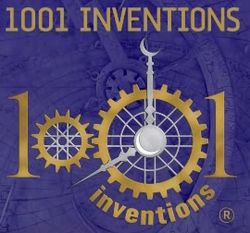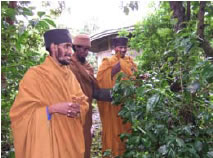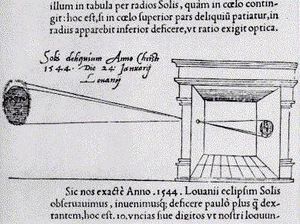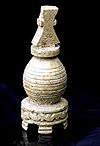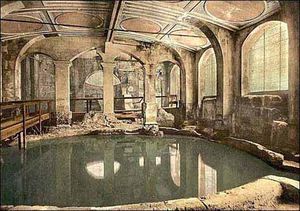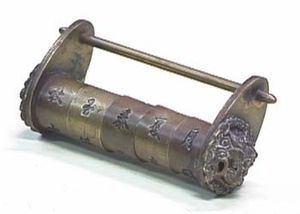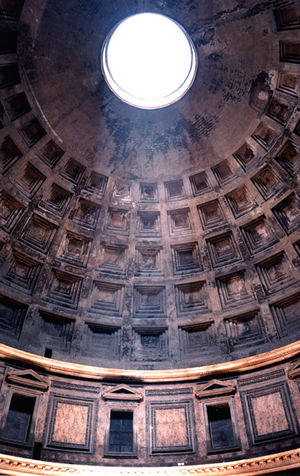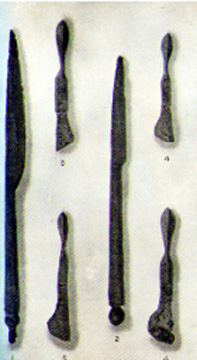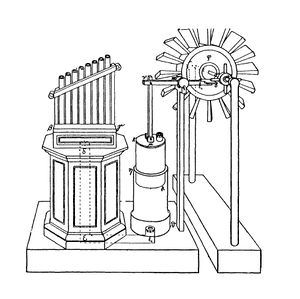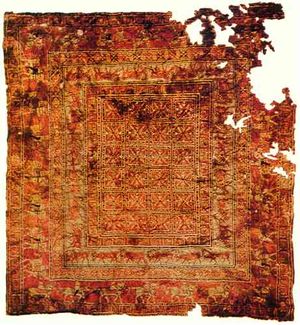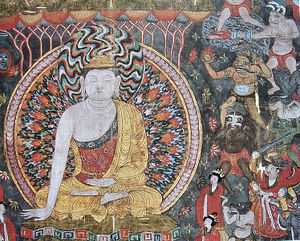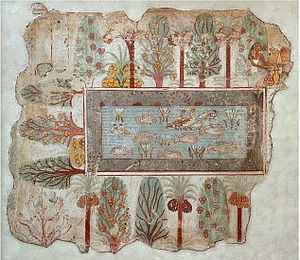Jak islámští vynálezci nezměnili svět
-----NA PŘEKLADU SE DĚLÁ----------
Poznámka: Paul Vallely, autor "How Islamic inventors changed the world" (Jak islámští vynálezci změnili svět), byl kontaktován ohledně tvrzení v tomto článku, nicméně dosud jsme nedostali odpověď.
Úvod
Za posledních pár let bylo mnoho vynálezů připisováno islámským vynálezcům, které ve skutečnosti existovaly v před-islámské době, nebo byly vynalezeny jinými kulturami, nebo oboje. Tato tvrzení byla také vnucována veřejnosti v rámci národního turné, které se otevřelo u exhibice v Museum of Science a Industry v Manchesteru a University of Manchester v Anglii.
Pro oslavu této série událostí, byl Paulem Vallelyem napsán článek s názvem “How Islamic inventors changed the world” (Jak islámští vynálezci změnili svět), publikovaný u The Independent 11. března 2006. Tento nepřesný článek získal velkou chválu od muslimů a hojně koluje po islámských stránkách, fórech, blozích a je dokonce používán jako zdroj (pro potvrzení lživých tvrzení o islámských vynálezech) ve více, než dvaceti [1] různých článků na Wikipedii.
Paul Vallely odvážně začal s následujícím tvrzením: "Od kafe, přes šachy, až ke třem hodům, muslimský svět nám dal mnoho inovací, které bereme jako samozřejmost v každodenním životě. Při otevření nové výstavy, Paul Vallely nominuje 20 nejvlivnějších- a identifikuje jejich geniální vynálezce."[2] Tento článek vyjmenovává a zkoumá všech dvacet “Islámských vynálezů, které změnily svět”, a při tom ukáže jejich opravdové vynálezce a opravdovou roli islámu/muslimů, pokud tam vůbec nějaká byla.
Vynálezy
Kafe
The legend being referred to by Paul Vallely is expounded upon in the Coffee History, found on decentcoffee.com:
"Arabian coffee-drinking began almost 12 centuries ago (850 A.D.) when an Abyssinian goat herder named Khalid noticed that while the afternoon sun made him drowsy, his flock frolicked and skipped about after nibbling at some berries. Khalid either ate the berries whole, or ground and boiled them.
When his wife saw how energetic the normally exhausted Khalid was, she urged him to share this miraculous discovery with the local holy man at the monastery. The chief monk did not share Khalid's enthusiasm. Declaring the berries "the work of the Devil," he flung them into a fire to banish their offending presence. Soon the room filled with the delicious aroma of roasting berries, and other monks hurried in to discover the source of this new delight."
Notice above, that the passage says the goat herder named Khalid (or Kaldi as he is named in another version of the story) was an Abyssinian. Abyssinians were predominantly Orthodox Christians. In addition, there is no such thing as monasteries or monks in Islam. In fact, it is forbidden (Quran 57:027). Therefore, if this legend were to be true, Khalid (or Kaldi) would not have been a Muslim, but a Christian.
Also, the discovery of coffee, according to the maronite monk Antonius Faustus Naironus (1635–1707 AD), differs somewhat from the above tale. In "De saluberrima potione Cahue, seu Cafe nuncupata discursus" (1671) he writes, that a herdsman complained to the Prior of a nearby monastery in Abyssinia, that his animals could not sleep. Two monks, together with the herdsman, were sent by their superior to investigate what it was the animals were eating. They discovered coffee plants which they took back to the monastery, where they brewed a beverage from its fruits. They passed the whole night in pleasant conversation, without any fatigue.[3]
Vidění
The basic optical principles of the pinhole are commented on in Chinese texts from the 5th century BC..[4] Both the claims, that he created intromission theory, and that he invented the pin-hole camera, are false. Intromission theory (opposing emission theory) originated in Greek philosophy, and its proponents included Aristotle, Galen, and Empedocles. Giovanni Battista della Porta (1538–1615), a scientist from Naples, was long thought to have been the inventor, due to his description found inside Magia naturalis (1558). However, the first published picture of a pin-hole camera is a drawing in Gemma Frisius' De Radio Astronomica et Geometrica (1545).[5]
While both the Latin and Arabic languages have borrowed from each other, the Latin language actually pre-dates classic Arabic (the precursor to modern Arabic) by at least 1,600 years. The term “camera” was not derived from the Arabic word “qamara”. “Camera” is a Latin word meaning a vaulted or arched space, derived from the Greek καμαρα, which refers to anything with an arched cover. The Italian word "camera", the French word "chambre", and the English word "chamber" all share the same Latin root. "Camera obscura" literally meaning a “dark room”.[6][7] The term “camera”, as applied today, was first coined by Johannes Kepler (1571–1630). The Arabic word “qamara” has almost certainly been borrowed from the Latin word "camera", and at best the similarity between the two words is a coincidence.[5]
Šachy
British archaeologists in July 2002 unearthed an ivory chess piece, at a Byzantine palace in southern Albania proving that Europeans were playing chess a lot earlier than what was previously thought. The recent discoveries, dating back to the 6th Century (500 years older than any other), seem to have been largely ignored to allow Muslims to claim that they were the real brains that introduced chess to the idiotic West 400 years later, through Spain in the 10th Century.[8] And while the form of chess we know today was largely (though not completely) developed in Persia, it was by Zoroastrian (rather than Islamic) Persians prior to the Muslim Arab invasions. Also ironic is the fact that chess is forbidden in Islam, as it was condemned by Muhammad who compared playing chess with dying ones hand with the flesh and blood of swine.[9][10] So in reality, Paul Vallely and Muslims themselves claiming Islam was the cause of the spread of chess to Europe is an offence to the pious, and would no doubt have Muhammad rolling in his grave.
Létání
To get to the root of the facts concerning who was the first to fly, one must go to the very basics first. As far as flying is concerned, at the beginning were the kites, and these were a Chinese invention. They date back as far as 3,000 years, where they were made from bamboo and silk in China. The earliest written account of kite flying was about 200 BC. In 478 BC a Chinese Philosopher, Mo Zi, spent three years making a hawk from light wood or bamboo which sailed with the wind. It could fly, but after one day’s trial it was wrecked. Kites were also used in Chinese warfare for years. They carried hideously painted faces, pipes and strings that gave noises to frighten the enemy.
Many attempts to use kites to fly men were also made, the earliest recorded success was very brutal. In AD 550 Emperor Kao Yang overcome his powerful enemies the Thopa and Yuan families. He ordered that the surviving Thopas and Yuan to be fitted out with bamboo-mat wings and cast from the top of the Tower of the Golden phoenix. All died. Other captives were attached to kites cut out in the form of owls and launched from the tower. Only one of the captives survived after flying 2.5 Km. Later that survivor, named Yuan Huang-Thou was starved to death. The Chinese also tried to produce flying machines. In the book Pao Phu Tzu, dated AD 320, Ko Hung states: “Some have made flying cars with wood, using ox-leather straps fastened to returning blades to set the machines in motion”. He is clearly describing rotating blades attached to a spinning axle and driven by a (leather) belt that is a rotor top the principal of which underlie the modern-day helicopter. It seems that the system worked because flying cars had been used. The machine, known as “bamboo dragonfly”, is still used today as a child’s toy.[11][12][13]
In the West, the ancient Greek engineer, Hero of Alexandria, worked with air pressure and steam to create sources of power. One experiment that he developed was the aeolipile, which used jets of steam to create rotary motion. The importance of the aeolipile is that it marks the start of engine invention—engine created movement will later prove essential in the history of flight.[14]
Given all of the above information, how can anyone possibly accredit the invention of flight to a 9th century Muslim jumping off a mosque in Spain?
Mytí
The first issue we need to address here, is the "Muslim" that Paul Vallely is referring to. His name was Sake Dean Mahomed and he was not a Muslim, but a convert to Christianity.[15] Born to Muslim parents in 1759, He converted to Christianity and married the Anglo-Irish gentlewoman, Jane Daly, in an Anglican ceremony in 1786[16] (long before opening "Mahomed's Indian Vapour Baths" in 1821).[17] Two of his children (Amelia and Henry) were also baptised into the Anglican faith, and one of his grandsons, Rev. James Kerriman Mahomed, was appointed as the vicar of Hove, Sussex.[18] Also worthy of mention is the fact that Islam is not the only religion which dictates rules on personal cleanliness. The Jews too have rules governing hygiene.
A soap-like material found in clay cylinders during the excavation of ancient Babylon is evidence that soapmaking was known as early as 2800 BC. Inscriptions on the cylinders say that fats were boiled with ashes, which is a method of making soap, but do not refer to the purpose of the "soap." Such materials were later used as hair styling aids. Like the ancient Egyptians before them, daily bathing was an important event in the ancient Roman world[19] and a common custom in Japan during the Middle Ages. And in Iceland, pools warmed with water from hot springs were popular gathering places on Saturday evenings. Soapmaking was an established craft in Europe by the 7th century. Soapmaker guilds guarded their trade secrets closely. Vegetable and animal oils were used with ashes of plants, along with fragrance. Gradually more varieties of soap became available for shaving and shampooing, as well as bathing and laundering. The English began making soap during the 12th century. The soap business was so good that in 1622, King James I granted a monopoly to a soapmaker for $100,000 a year. Well into the 19th century, soap was heavily taxed as a luxury item in several countries. When the high tax was removed, soap became available to ordinary people, and cleanliness standards improved. Commercial soapmaking in the American colonies began in 1608 with the arrival of several soapmakers on the second ship from England to reach Jamestown, VA. The science of modern soapmaking was bom in the 1820's with the discovery by French chemist Michel Eugene Chevreul, of the chemical nature and relationship of fats, glycerine and fatty acids. His studies established the basis for both fat and soap chemistry.[20]
Destilace
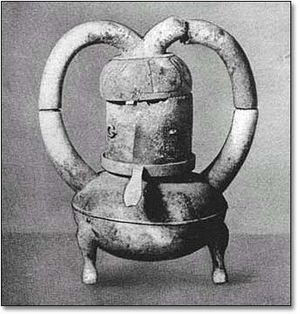
Speculation has linked some Egyptian illustrations with distillation, but the earliest evidence for its invention so far is a distillation apparatus and terra-cotta perfume containers recently identified in the Indus Valley (pre-Islamic Pakistan) dating from around 3,000 BC, and Miriam the Prophetess (also known as “Maria the Jewess”) invented the kerotakis, an early still dated around the 1st century AD.[22] The first firm documentary evidence for distillation in the West comes from Greek historian Herodotus' record of the method of distilling turpentine dated 425 BC.[23] Also, the origins of whisky is dated to the 5th century AD, introduced to Ireland by Saint Patrick (390–461 AD), the patron of the Irish.[24]So the Arabs may have improved upon the process of distillation some 3500 years later, but they most definitely did not invent it.
It is also of great interest to note that the authorship of many books previously attributed to Jabir ibn Hayyan (including "his" most famous work, Summa Perfectionis) have now been attributed to an unknown European alchemist, sometimes to the little-known Paul of Taranto, writing shortly after 1300 AD.[25] According to the Encyclopædia Britannica:
"[Geber was an] unknown author of several books that were among the most influential works on alchemy and metallurgy during the 14th and 15th centuries.
The name Geber, a Latinized form of Jābir, was adopted because of the great reputation of the 8th-century Arab alchemist Jābir ibn Ḥayyān. A number of Arabic scientific works credited to Jābir were translated into Latin during the 11th to 13th centuries. Thus, when an author who was probably a practicing Spanish alchemist began to write in about 1310, he adopted the westernized form of the name, Geber, to give added authority to his work, which nevertheless reflected 14th-century European alchemical practices rather than earlier Arab ones.
Four works by Geber are known: Summa perfectionis magisterii (The Sum of Perfection or the Perfect Magistery, 1678), Liber fornacum (Book of Furnaces, 1678), De investigatione perfectionis (The Investigation of Perfection, 1678), and De inventione veritatis (The Invention of Verity, 1678). They are the clearest expression of alchemical theory and the most important set of laboratory directions to appear before the 16th century. Accordingly, they were widely read and extremely influential in a field where mysticism, secrecy, and obscurity were the usual rule."[26]
The crank-shaft
Unfortunately for our ingenious Muslim engineer al-Jazari, the crank-shaft was known to the Chinese of the Han Dynasty.[27] The Han Dynasty lasted from 206 BC to 220 AD. By the 1st century AD cranks were used on Roman medical devices, but it was not until 834 AD where we find proof of the crank in Europe. A picture in a graphic codex of a man sharpening a sword on a grindstone turned by a crank.[27][28] 206 BC to 834 AD is certainly a lot earlier than when Paul Vallely claims a 12th century Muslim invented 'one of the most important mechanical inventions in the history of humankind'. What Al-Jazari described was a crank and connecting rod system in a water pump. He incorporated a crankshaft, but it was unnecessarily complex indicating that he did not fully understand the concept of power conversion.[29]
Piston technology was also used by Hero of Alexandria in the 1st century AD with the creation of the worlds first steam-powered engine—the aeolipile, more than a thousand years before al-Jazari. (please refer to Invention 4: Flying for further details.) In his works "Pneumatica" and "Automata" he also described over a hundred machines and automata, including mechanical singing birds, puppets, a fire engine, a wind organ (please refer to Invention 11: The windmill for further details), and a coin-operated machine, so if anyone deserves the title given to al-Jazari by Paul Vallely as the "father of robotics" it's Hero of Alexandria. It must also be noted that Hero's works "Mechanica" (in three books) survive only in their Arabic translations, so the Muslims had access to all this pre-Islamic genius,[30] yet writing a factually accurate article on Islamic achievements seems to have proved too much for some.
As for the water clock, the ancient Egyptians used a time mechanism run by flowing water. One of the oldest was found in the tomb of an Egyptian pharaoh buried in 1500 BC, and the Chinese began developing mechanized clocks from around 200 BC. The Greeks also measured time with various types of water clocks. The more impressive mechanized water clocks were developed between 100 BC and 500 AD by Greek and Roman horologists and astronomers.[31] What we now know as the Antikythera mechanism was discovered among a shipwreck in 1900 off the island of Antikythera.
Science historian Derek Price, concluded that it was an ancient computer used to predict the positions of the sun and moon on any given date. Michael Wright, the curator of mechanical engineering at the Science Museum in London, thinks that the original device modelled the entire known solar system. Ancient Greek sources make references to such devices so this is highly plausible. Roman philosopher Marcus Tullius Cicero (106–43 BC), writes of a device “recently constructed by our friend Poseidonius, which at each revolution reproduces the same motions of the sun, the moon and the five planets.” Greek mathematician, physicist, engineer, inventor, and astronomer Archimedes of Syracuse (287–212 BC) is also said to have made such a device.[32][33] By the 9th century AD a mechanical timekeeper had been developed that lacked only an escapement mechanism.
And what of the Combination Lock, did al-Jazari invent it? Again, the answer is an emphatic no. The earliest known combination lock was unearthed in a Roman period tomb in Kerameikos, Athens.[34] The ancient Chinese were also responsible for the creation of some of the earliest key-operated padlocks and beautiful letter-combination padlocks.[35][36]
Quilting
It is interesting that the author states himself that it is "not clear whether it was invented in the Muslim world", yet still chose to include quilting as an Islamic invention. However, the evidence against quilting being a Muslim invention is very clear, though it may have come to Europe through the middle East. The actual origins of quilting remains unknown, but its history can so far be traced to ancient China and Egypt as long ago as 3400 BC[37] with the discovery of a quilted mantle on a carved ivory figure of a Pharaoh of the Egyptian First Dynasty. Moreover, in 1924 archaeologists discovered a quilted floor covering in Mongolia.[38] The estimated age somewhere between the 1st century BC to the 2nd century AD. There are also numerous references to quilts in literature and inventories of estates,[38] and more recently in September 2007 an ancient male mummy was discovered in Xinjiang, China, wrapped in a cotton quilt.[39]
Architektura
When it comes to revolutionary architectural inventions, nothing is greater than the creation of concrete, a material perfected by the Romans. This enabled them to erect buildings that would have been impossible to construct using the traditional stone post-and-lintel system. This development made possible the construction of the amphitheatres, baths and hillside temples of the Roman world.[40] With that said and done, although the pointed arch only came into general use in the 13th century, it was in fact the Assyrians (not the Muslims) who first used it as early as 722 BC.[41]
As for the Islamic techniques of domebuilding; the best example of a dome in the ancient world is the Pantheon in Rome, built almost 500 years before Islam in 118–135 AD by Apollodorus of Damascus and again only made possible through the concrete mixture perfected by the Romans. Originally a temple to the Roman deities, it has been a Christian church since the 7th century. It is an important and impressive feat of design, a building which after almost 2,000 years of continuous use has its original roof intact. The dome has a span of 43.2 metres (142 feet). It remained as the greatest dome in the world until the 15th century construction of the Florence Cathedral (1420–36).
The second most impressive pre-Islamic dome is that of the Hagia Sophia (the Church of the Holy Wisdom) in Istanbul, Turkey. Built under the supervision of Byzantine Emperor Justinian during the years 532–537 AD, it was converted into a mosque by the invading Muslims who conquered Constantinople in 1453 AD. The dome has a breadth of 31 metres (102 feet) and opposed to the article's claims, we find Muslims borrowing from older Christian architecture. It was in fact this 6th century Byzantine church which was used over a thousand years later as a model for many of the Ottoman mosques including the Sultan Ahmed Mosque (completed 1616 AD), the Şehzade Mosque (completed 1548 AD), the Süleymaniye Mosque (completed 1557 AD), the Rüstem Pasha Mosque (completed 1563 AD), and the Kılıç Ali Paşa Mosque (completed 1580 AD).[42]
The Article also mentions that rose windows are an Islamic invention, but its origins may be traced back to the Roman oculus, again found on top of the dome of the Pantheon. Also, the invention of rose windows depend entirely on glass and craftsmanship. Glass making originated in the Near East around 2,000 BC. The earliest makers pressed glass into crude molds. Around 1500 BC, finer vessels were being made in Egypt. The best glass manufacturers and exporters of this time were the Phoenicians who had a great supply of silica rich sands. Glass blowing developed around the 1st century BC in Palestine.[43] The earliest known stained glass is Saxon (7th century, Jarrow), and the making of it was regarded as a mystery.
And finally, we have ribbed vaulting which was developed from Romanesque architecture by medieval European builders[44] and which was first used in St. Etienne, France. The earliest surviving example of ribbed vaulting can be found in Durham Cathedral (built from 1093–1133 AD) in Durham, England.[45]
With all these facts considered, we think it's safe to assume that architectural development in Europe and the rest of the non-Islamic world would and indeed did move along fine without the so-called 'Muslim genius'.
Nástroje
More than a thousand years before al-Zahrawi, the Greek and Roman physicians in the Classical World had access to a variety of surgical instruments. This is known through several ancient texts which give brief descriptions and also from a 1887 find in the ruins of Pompeii. A house that belonged to a Greek surgeon in 79 AD was identified by its large stores of surgical equipment numbering over a hundred. These medical instruments, which are now on display in museums around the world, were all available to the ancient Greek physician Hippocrates (460–370 BC) who lived more than a thousand years before Islam, and many of them in a similar form are still being used today. These instruments include a variety of scalpels, hooks, uvula-crushing forceps, bone drills, bone forceps, catheters and bladder sounds, vaginal speculum, and even a portable medicine chest to carry them in.[46] It was also the Greek physician and medical researcher Claudius Galenus (129–217 AD), someone who greatly influenced Western medical science, who first used catgut to close wounds and not al-Zahrawi. In fact "Muslim" physician Ibn Sīnā (Avicenna) 700 years later (920 AD) used a pig product.[47] The actions of a pious Muslim, we're sure.
As for the circulation of the blood, it may have been described by Muslim medic Ibn Nafis 300 years before William Harvey, but the Chinese Book of Medicine describes this 1,600 years before Ibn Nafis.[48]
The article also alleges that Muslim doctors first developed hollow needles to suck cataracts from the eye, and anaesthetics of opium and alcohol mixes. This is not so. Cataract surgery has been performed for many centuries. The earliest reference to cataract surgery was written by the Hindu surgeon Susruta in manuscripts dating from the 5th century BC. In Rome, archaeologists found surgical instruments used to treat cataract dating back to the 1st and 2nd century AD. Hollow needles were used to break up the cataract and remove it with suction.[49] Anaesthetics of opium and alcohol mixes were used both by the ancient Chinese and Romans. Greek physician, pharmacologist, and botanist Pedanius Dioscorides (40–90 AD) in his work Materia Medica (one of the most influential herbal books in history) referred to the taking of an alcoholic extract before an operation. This would suggest that it was typical for the surgeons of ancient Rome to decrease pain of an operation by giving their patients sedative drugs.[50]
Větrný mlýn
The windmill was not invented in the year 634 for a Persian caliph. Although the Arabs invaded Persia in 634 AD, contrary to the articles claims, there was no caliph in Persia at that time; he was in Medina, Saudi Arabia. Caliph Abu Bakr died early that year and Umar ibn al-Khattab took over. Fīrūz (Abu-Lu'lu'ah), the Arab-owned non-Muslim slave, who in 644 AD assassinated Caliph Umar in the mosque at Medina, is described by Islamic sources as a Persian builder of windmills.[51] Therefore, the construction of windmills was an already established craft in Persia, antedating the presence of Islam.
If we look to the history behind the development of windmills, the first rotary mills were discovered in Catal Hayuk in Turkey and existed 8,000 years ago,[52] while the first windmills were developed much later to automate the tasks of grain-grinding and water-pumping. One of the earliest watermills mentioned can be found in 1st century BC Greek writings, where a watermill was called a hydraletēs, but because of the heavy use of slave labor we do not find the first archeological evidence of watermills until the 4th and 5th century AD. [53] The earliest mention of a type of windmill can be found in the book Pneumatica written by a 1st century AD writer called Hero, in it he describes the creation of a type of windpowered organ. [54] The idea was never worked out however and we don't find the earliest-known design of the vertical axis system until developed in Persia about 500–900 AD. China is also often claimed as the birthplace of the windmill. The belief that it was invented in China more than 2,000 years ago is widespread and may be accurate, but the earliest actual documentation of a Chinese windmill was in 1219 AD by the Chinese statesman Yehlu Chhu-Tshai.[55]
Inoculation
It was smallpox that was used for inoculation by the Turks, not cowpox. Inoculation was widespread at the time, and involved the use of smallpox scabs. The use of the much less dangerous cowpox virus to induce immunity is known not as inoculation, but as vaccination. It was in fact Jenner who first reported the use of cowpox to vaccinate against the much more lethal smallpox, hence he invented vaccination. And Yes, Jenner and Pasteur were not the inventors of inoculation but neither were the Muslims. What Paul seems to be continually doing is referring to anything that originated from the Eastern hemisphere (regardless of whether it was before or after the advent of Islam or not) as originating from 'the Muslim world' when even the most unenlightent amongst us will realize that China and India are not a part of this so-called Muslim world. It has been said that Inoculation against smallpox began in China during the 10th century,[11] but the earliest documented reference to smallpox inoculation in China comes from text written in 1549.[56] The earliest known attempts to produce artificial immunity involved powdered smallpox scabs being blown into the sinuses, and in the 17th century, they prepared pills made from the fleas of cows in an effort to prevent the disease. In India, physicians conferred immunity by applying scabs to the scarified skin of the healthy. The technique of inoculation spread west to Turkey and then Europe.[57]
The fountain pen
The history of the fountain pen cannot begin otherwise than with the quill pen. The quill pen was used for the writings of Egyptian kings 4,000 years ago. They most often used a goose feather carved into a sharp tip and dipped into ink of vegetable origin. Though the first pencil was invented by Conrad Gessner in 1567[58], it remained like this until the end of the 18th century when the metal pen was invented. Daniel Schwenter wrote about the idea of creating a fountain pen in his Delicia Physic-Mathematicae in 1636 [59]; efforts to manufacture a pen with its own ink supply began in the year 1656. For example, Samuel Pepys had one in the year 1663. It functioned in such a way that a small pipe above the tip of the feather was filled with ink by means of a small piston. But a slightly more practically usable pen came to the world in the 19th century. A fountain pen which functioned on the same principle (a pen with a piston) was created by the inventor Folsch in 1809.[60] Later in 1931, László Bíró presented the first ballpoint pen at the Budapest world fair,[61] the ballpoint pen was designed to use better ink that would not clog or smear.[62]
Those who claim that the fountain pen was invented in AD 953 by a Muslim need to produce both the evidence of a fountain pen, and evidence of the type of ink used.
The system of numbering
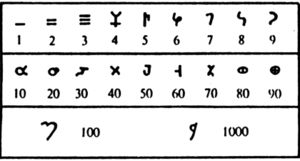
Algebra may have been named after a book by al-Khwarizmi titled Al-Jabr wa-al-Muqabilah, but the origins of algebra itself can be traced to the ancient Babylonians who were able to do calculations in an algorithmic fashion.[63] Having something named after what popularised or refined it by no means makes it the inventor, and by doing so you would have to discount the works of mathematician Diophantus of Alexandria (200 and 214 AD–284 and 298 AD) who authored a series of books called "Arithmetica" and is commonly referred to as "the father of algebra".
Paul Vallely begrudgingly admits that the system of numbering in use all round the world is 'probably' Indian in origin, yet the title of the supposed Islamic invention still remains "The system of numbering". The first known use of numbers dates back to around 30,000 BC, but it is universally accepted that the system of numbering we use today (the digits 0 to 9) was invented in India.[64][65] The reason why they are referred to as "Arabic" numerals in the West is due to them being introduced to the Europeans through the Arabs, who in the same way had earlier received them from the Hindus. Likewise, the Arabs themselves commonly refer to them as "Hindu numerals".[66]
The use of zero as a number is found in many ancient Indian texts. The concept of negative numbers was recognised between 100–50 BC by the Chinese. Greek and Indian mathematicians studied the theory of rational numbers. (The best known of these works is Euclid's Elements, dated 300 BC. Euclid is also often referred to as the "Father of Geometry".) The earliest use of irrational numbers is in the Indian Sulba Sutras (800–500 BC). The first results concerning transcendental numbers were made by Johann Heinrich Lambert in 1761. The earliest known conception of mathematical infinity appears in the Hindu text Yajur Veda (1,400 and 1,000 BC). The earliest reference to square roots of negative numbers were made by Greek mathematician and inventor Heron of Alexandria (10–70 AD). Prime numbers have been studied throughout recorded history. The mathematical branch of Trigonometry has been studied by the ancient Egyptians and Babylonians, but it was the ancient Greeks who proved theorems that are equivalent to modern trigonometric formulae. And finally, the earliest known algorithms were developed by ancient Babylonians (1600 BC).[67][68][69][70][71]
As for al-Kindi, while he is thought to be the earliest to describe frequency analysis, the technique itself may not have been discovered by al-Kindi as claimed. Nobody knows who actually discovered/invented/realized that the frequencies of letters could be used to break ciphers,[72] and cryptology itself can be traced back to the time of Julius Caesar.
Three course meal
Having to include the three course meal in any religion's top 20 list of inventions is embarrassing. The expression scraping the barrel comes to mind, but did a Muslim actually invent it? Unsurprisingly, the answer is no. The Romans invaded Britain in 43 AD (almost 600 years before the advent of Islam) and with them they brought the concept of the three-course meal[73] which consisted of a first course, main course, and dessert.[74] A typical starter/first course would be haddock, herring, mullet, or mackerel; the main course roasted beef, pork, or venison served with a prepared sauce and boiled vegetables; followed by a dessert of stuffed fried dates, apples soaked in a cream sauce, or pastries covered in honey and pepper; and to wash it all down, plenty of wine.[75] It was the pre-Islamic Persians who introduced the dessert into Asia Minor as far as Ephesus (condemning the Greeks for its omission in meals).
Also, Abbas ibn Firnas did not invent crystal glass. Clear glass appeared during the 15th century in Venice, and was called cristallo. Crystal was invented 175 years later, after glassmaker George Ravenscroft added lead oxide to glass, creating lead crystal glass.[76]; [77]
Carpets
The earliest known carpet was discovered by Russian Professor Rudenko in 1949 during excavations of burial mounds in the Altai Mountains in Siberia. Called the Pazyryk rug,[78][79] it dates from the fifth century BC[80] and is now kept in the Hermitage museum of St. Petersburg.[81] It was preserved from decay, due to water seeping into the burial mound and freezing.[82] The advanced weaving technique used in the Pazyryk carpet indicates a long history of evolution and experience in this art. Most experts believe that the Pazyryk carpet is a late achievement of at least one thousand years of technique evolution and history. Evidence suggests that some forms of rug-weaving were used in Egypt, Mesopotamia, and the Middle East and Asia about 4,000 years ago. Therefore, the carpet is a pre-Islamic invention.
What of the West and the flooring being referred to by Paul Vallely? The Colosseum in Rome which was completed in 80 AD had wooden (not earthy) flooring. In fact, the typical Roman home as early as the 2nd century BC had mosaic flooring, as found in the "House of the Tragic Poet" in Pompeii, Italy.[83]; [84] The Romans also made use of rugs on the floors and the walls of their palaces. In 47 BC when the Egyptians banished Queen Cleopatra from Egypt, replacing her with her brother, she had herself delivered to the Roman Emperor Julius Caesar, smuggled inside a rolled up carpet. Their love for carpets was so great that many considered them to be more valuable than money and they even used them to pay their taxes.[85]
The modern cheque
The ancient Romans are believed to have used an early form of cheque known as praescriptiones in the first century BC,[86] and the saqq (or sakk, which developed into the modern word cheque)[87] system being referred to by Paul Vallely was a 3rd century pre-Islamic innovation of the Persian Sassanid Empire. Modern cheques need paper to be written, so clues to the invention of cheques can be traced following the lead of the invention of paper. Closely related is also the history of money and banking.
Paper is thought to have been invented in China 1st century BC. It was kept as a secret for five centuries and went to Japan in AD 610. It was not used only for writing and books (The Chinese are also responsible for the invention of printing, possibly between the 4th and 7th century AD.) but also for making umbrellas, flags, house holds, toilet paper, and even armour so strong as to resist arrows. More to the point of cheques, they used it for the first promissory note, the first paper money. The invention was necessitated by the highway men who became so numerous that the merchants were not able to pay their taxes to the state. The state machinery was vital to the Chinese Empire to survive for so many thousand years. The civil servants brought the idea of notes marked with certain value that can be exchanged to gold at the end of the journey. Thus was developed the first cheques in history.[11][88][89][90]
Země je kulatá
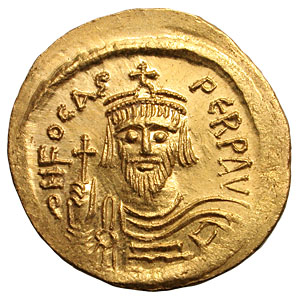
The fact that the Earth is spherical was common knowledge among medieval Europeans as proven by the dominant textbooks of the Early Middle Ages, the orb (globus cruciger; Latin for "cross-bearing orb") a Christian symbol representing Christ's (the cross) dominion over the world (the orb) used in the regalia of many kingdoms and of the Holy Roman Empire from as early as 395 and throughout the Middle Ages,[91] and the writings of early Christian scholars including Anicius Boëthius (480–524 AD), Bishop Isidore of Seville (560–636 AD), Bishop Rabanus Maurus (780–856 AD), the monk Bede (672–735 AD), Bishop Vergilius of Salzburg (700–784 AD) and the most important and widely taught theologian of the Middle Ages; Thomas Aquinas (1225–1274 AD). The belief that medieval Christians believed in a flat earth is false,[92] and was listed by the Historical Association of Britain in 1945 as the second of twenty in a pamphlet on common errors in history.[93] This should not really come as much of a surprise when you consider that the Ancient Greeks Pythagoras (570–495 BC), Aristotle (384–322 BC) and Hipparchus (190–120 BC) also concluded that the earth is spherical half a millennium earlier.
Eratosthenes (275–194 BC) in 240 BC measured the circumference of the earth to a figure very close to what we know of at present. He measured the distance between Alexandria and Aswan by pacers and also measured the curvature of the earth between these two points on the surface of the sphere (earth) and came to the figure of the circumference of the earth. Eratosthenes' method was later to be employed by Hermannus Contractus (1013–1054 AD) a medieval Christian scholar. The Greek philosopher and mathematician Aristarchus (320–230 BC) even knew the Earth revolves around the Sun and not the other way around (i.e. geocentrism).[94]
In the East, the works of the classical Indian astronomer and mathematician Aryabhata (476–550 AD) also deal with the sphericity of the Earth and the motion of the planets. The final two parts of his Sanskrit magnum opus the Aryabhatiya, which were named the "Kalakriya" (reckoning of time) and the "Gola" (ball), state that the earth is spherical and that its circumference is 4,967 yojanas, which in modern units is 39,968 km (24,835 mi), which is close to the current equatorial value of 40,075 km (24,901 mi).[95] He also stated that the apparent rotation of the celestial objects was due to the actual rotation of the earth, calculating the length of the sidereal day to be 23 hours, 56 minutes, and 4.1 seconds.[96]
In conclusion; everything that has been attributed to Muslim Arabs by Paul Vallely, had already been discovered by not only the pre-Islamic East, but also by the preChristian Greeks. The Islamic faith stifles scientific progress and nothing demonstrates this as well as the modern-day belief that the Earth is flat. As recently as 1993 the supreme religious authority of Saudi Arabia Sheik Abdul-Aziz Ibn Baaz declared "The earth is flat. Whoever claims it is round is an atheist deserving of punishment."[97] and in October 2007 on Al-Fayhaa TV in Iraq, a Muslim scientist also declared that the Earth is flat as evidenced by Qur'anic verses and that the Sun is much smaller than the Earth and revolves around it.[98]
Střelný prach
As the article readily admits; the Chinese invented saltpetre (from Medieval Latin sal petrae: "stone salt" or possibly "salt of Petra") gunpowder, and saltpetre is in fact potassium nitrate.[99] There is also only one reference from the Crusade of the Muslims launching a missile of some kind, but it did no damage. Were gunpowder in actual military use by the times of the Crusades, the first device to apply it in would have been a cannon, but it was in fact the Chinese who fired the first cannon.[100]
Although the date of their introduction is uncertain, writings indicate that in 994 AD the Chinese used fire arrows in battle. Fire arrows were traditional arrows tipped with flammable materials like pitch, bitumen, or resin. In 994 AD the Chinese city of Tzu T'ung was attacked by an army of 100,000 men. The commander of the defensive forces, named Chang Yung, ordered a response to the attack using artillery fire made up of catapulted stones and fire arrows launched by bows.
In 1045, a Chinese government official named Tseng Kung-Liang wrote a complete account of the Chinese use of gunpowder, including its adaptation to weaponry. Called "Wu-ching Tsung-yao" (Complete Compendium of Military Classics) the work detailed the use of ballistic fire arrows not launched by bows, but by charges of gunpowder. While the date of their introduction is uncertain, the fire arrows launched by gunpowder are considered to be the first true rockets. These fire arrows were traditional feathered arrows propelled by ignited gunpowder housed in a tube tied to the arrow. The fire arrows carried flammable materials or sometimes poison-coated heads. In a form more closely resembling modern rockets, the gunpowder tube was lengthened to the tip of the arrow and given a pointed nose, eliminating the need for a traditional arrowhead.
In 1258, the Mongols were reported to have used gunpowder-propelled fire arrows in their effort to capture the Arab city of Baghdad. The Mongols reportedly launched gunpowder propelled fire arrows from ships during their attacks on Japan in 1274 and 1281. By the end of the 13th century, armies of Japan, Java, Korea, and India are believed to have acquired sufficient knowledge of gunpowder propelled fire arrows to begin using them against the Mongols. Use of the weapons quickly spread throughout Asia and Eastern Europe.
At the same time gunpowder propelled fire arrows were blazing in battle, scientific papers on the subject of the preparation of gunpowder and its application in weaponry were being published in Europe. Notable works were prepared by Roger Bacon, Albertus Magnus, and Marchus Graecus before the close of the 13th Century. In 1379, an Italian named Muratori used the word "rochetta" when he described types of gunpowder propelled fire arrows used in medieval times. This is believed to be the first use of the word later translated in English as "rocket".[101]
Zahrady
Gardens were an Arab tradition long before Islam, so for Islam to claim this as an invention ignores thousands of years of pre-Islamic Arab culture, not to mention the legendary Hanging Gardens of Babylon which were built by the Chaldean king Nebuchadnezzar II around 600 BC to please his sick wife, Amytis of Media.[102] It also ignores the Roman tradition of gardens and fountains used for meditation and the beautifully artistic Chinese Suzhou gardens (770–476 BC) which were designed specifically for relaxation.[103] The oldest pictorial records of gardens are from Ancient Egyptian tomb paintings. Much like modern gardens, they came complete with shelters, pools, shady walks, pergolas, and plants growing in terracotta pots. In ancient times, temples contained what would be recognised as gardens. When they were closed to the public they became compounds for priests. Planting positions have been located in the Egyptian Temples of Hatshseput and Mentuhotep, and the Greek Temple of Hephaistos.[104] Also one of the centerpieces of a Roman period home was the oeci or (peristyle) garden. Sometimes the center included a fish pond or swimming pool instead of a garden. Depending on the size of the home, the floorplan could continue indefinitely, with gardens leading to rooms leading to other gardens.[83]
Závěr
Článek, který napsal Paul Vallely je zcela zavádějící. Vynechává, zkresluje a dělá chyby ohledně nejzákladnějších historických faktů, aby dal čtenáři falešný dojem. Nechá vás to přemýšlet nad tím, co ho mohlo vést k napsání takového klamného žurnalistického kousku? Tato ukázka měla ukázat 1001 islámských vynálezů. Pokud prvních dvacet jsou prokazatelně špatně, jak na tom asi bude zbylých 981? Neměly by Museum of Science and Industry a University of Manchester raději pátrat a zachovávat přesnou historii, než pomáhat stránkám jako MuslimHeritage.com, zvěčňovat chyby o historii a okrádat jiné civilizace, jako je starověká Čína, starověký Řím, Indie a před-islámský Egypt o uznání, které si právem zaslouží?
Nezávisle na Paul Vallelyově pokusu (kterému chybí fakta) změnit historii světa, aby ukázal islám v lepším světle a jeho levým pokusem bagatelizovat ne-islámské civilizace a jejich historické dědictví, zůstává to bolestivě jasné, že vědecký a literární pokrok je pomalý anebo stagnující v islámském světě, specificky kvůli islámské víře a jejím restrikcím na její stoupence.
Navíc, pan Isaac Newton, který byl Michaelem H. Hartem označen za druhého nejvlivnějšího člověka v historii, byl oddaným křesťanem,[105] ale jeho objevy nejsou nikdy popisovány jako "křesťanské objevy". Popravdě, toto nedávné označování vynálezů údajnými náboženskými přesvědčeními jejich vynálezců je docela zvláštní praktika. Pokud bychom měli udělat to samé pro vynálezy od následovatelů křesťanství, židovství, hinduismu nebo i řecko-římského pohanství, seznam by byl téměř nekonečný.
Viz také
- Články v českém jazyce (Articles in Czech) - Přehled všech článků v českém jazyce na WikiIslam
- Refutations - A hub page that leads to other articles related to Refutations
- Golden Age - A hub page that leads to other articles related to the "Golden Age"
Překlady
- Verze této stránky je také dostupná v těchto jazycích: anglicky. Další jazyky si můžete zvolit na liště vlevo.
Externí odkazy
- Islam’s Gifts to the World - A pictorial presentation of some of Islam's great contributions to the world. (satire)
- paulvallely.com - Paul Vallely's official site
Reference
- ↑ Wikipedia search term: "How Islamic inventors changed the world". Results: Inventions in medieval Islam, Timeline of historic inventions, Al-Jazari, Combination lock, Cheque, Islamic Golden Age, Al-Andalus, Science in medieval Islam, Medicine in medieval Islam, Alchemy and chemistry in medieval Islam, List of Muslim scientists, Paul Vallely, Pinhole camera, Timeline of science and engineering in the Islamic world, Inoculation, Ink, Timeline of medicine and medical technology, Science in the Middle Ages, History of medicine, History of technology, List of persons considered father or mother of a field, Wikipedia:Articles for deletion/Arab contributions to science. Retrieved December 24, 2009
- ↑ 2.00 2.01 2.02 2.03 2.04 2.05 2.06 2.07 2.08 2.09 2.10 2.11 2.12 2.13 2.14 2.15 2.16 2.17 2.18 2.19 2.20 Paul Vallely, "How Islamic inventors changed the world", The Independent, March 11, 2006
- ↑ Lake Tana Monastery Island Coffee - Ethiopia, Sea Island Coffee
- ↑ John H. Hammon, "The camera obscura," CRC Press, January 1, 1981
- ↑ 5.0 5.1 Jon Grepstad, Pinhole Photography, Photo.net, first published 1996, last updated December 18, 2003
- ↑ Michael Quinion, CAMERA/ˈkæmərə, World Wide Words, November 15, 1997
- ↑ Lynn H. Nelson, Latin Word List, University of Kansas, June 18, 1997
- ↑ "Ancient chess history unearthed", BBC News, July 27, 2002
- ↑ "Buraida reported on the authority of his father that Allah's Apostle (may peace be upon him) said: He who played chess is like one who dyed his hand with the flesh and blood of swine." - Sahih Muslim 28:5612
- ↑ "Yahya related to me from Malik from Nafi from Abdullah ibn Umar that when he found one of his family playing dice he beat him and destroyed the dice. Yahya said that he heard Malik say, "There is no good in chess, and he disapproved of it." Yahya said, "I heard him disapprove of playing it and other worthless games. He recited this ayat, 'What is there after the truth except going the wrong way.' " (Sura l0 ayat 32)." - Al-Muwatta 52:7
- ↑ 11.0 11.1 11.2 The Genius of China, 3,000 Years of Science, Discovery and Invention written by Robert K.G.Temple and published by Simon and Schuster, 1986. Currently out-of-print
- ↑ Encyclopedia Brittanica, 2004
- ↑ Oracle Bones, Stars, and Wheelbarrows, Ancient Chinese Science and Technology by Frank Ross,Jr., Houghton Miffin Company, New York, 1982
- ↑ Early History of Flight - Hero and the Aeolipile, About.com: Inventors
- ↑ The Travels of Dean Mahomet, University of California press, ISBN 9780520207172
- ↑ "Deen Mahomed (1759–1851): soldier, writer, businessman", The Oxford Dictionary of National Biography
- ↑ Tracing Your Roots > South Asian > Tracing South Asian Roots: Dean Mahomed Shampooing Surgeon in Brighton, Moving Here
- ↑ Ansari, Humayun (2004), The Infidel Within: The History of Muslims in Britain, 1800 to the Present, C. Hurst & Co. Publishers, pp. 57–8, ISBN 1850656851
- ↑ Barbara F. McManus, Roman Baths and Bathing, The College of New Rochelle, revised July 2003
- ↑ Soaps & Detergent: History, The American Cleaning Institute, Washington, DC
- ↑ R. Talon, La Science antique et medievale, Presses Universitaires de France, Paris, 1957, plate 16. Photo: Sir J. Needham.
- ↑ Fractional Distillation, The Chemical Heritage Foundation, 2002
- ↑ John Ferguson, History of distillation and essential oils, Aromatherapy Organisation Council
- ↑ History of Whisky and of Distillation (I), Celtic Whisky Compagnie
- ↑ Newman, William (1985). "New Light on the Identity of Geber", Sudhoffs Archiv fuer die Geschichte der Medizin und der Naturwissenschaften.
- ↑ Geber, Encyclopædia Britannica.
- ↑ 27.0 27.1 Major Engineering Events in History: First Use of the Crank 834 A.D., Trivia-Library, Inc.
- ↑ The Invention of the Crank, The Crank Powered Bicycle, Patent Pending Blog, April 7, 2005
- ↑ White Jr., Lynn (1962), Medieval Technology and Social Change, Oxford: At the Clarendon Press p.170 However, that al-Jazari did not entirely grasp the meaning of the crank for joining reciprocating with rotary motion is shown by his extraordinarily complex pump powered through a cog-wheel mounted eccentrically on its axle.
- ↑ "Science & Technology: Heron of Alexandria", Encyclopædia Britannica
- ↑ A walk through time - Early Clocks, The National Institute of Standards and Technology (NIST) Physics Laboratory
- ↑ "An Ancient Greek Computer?", World-Mysteries, The Economist Newspaper Limited 2002
- ↑ Michael Lahanas - The Antikythera computing device, the most complex instrument of antiquity, Hellenica
- ↑ Hoepfner, Wolfram (1970), "Ein Kombinationsschloss aus dem Kerameikos", Archäologischer Anzeiger 85(2):210–213
- ↑ The Beauty of Ancient Chinese Locks, The Ancient Chinese Machinery Cultural Foundation
- ↑ Schlage's History of Locks/ Inventive Ingenuity, Schlage Lock
- ↑ Averil Colby, Quilting, Macmillan Pub Co, 1979, ISBN 9780684160580
- ↑ 38.0 38.1 Julie Johnson, History of Quilting, Emporia State University
- ↑ Chen Lin, Male mummy found in Xinjiang, china.org.cn, September 20, 2007
- ↑ Roman Art and Architecture, MSN Encarta
- ↑ "arch", The Columbia Electronic Encyclopedia 2007, Columbia University Press (archived), http://encyclopedia2.thefreedictionary.com/arch.
- ↑ Holly Hayes, Hagia Sophia, Istanbul, Sacred Destinations, September 19, 2009
- ↑ Jamie Humphrey and Linda Phelps, Stained Glass, Europe, Medieval, Smith College History of Science, Museum of Ancient Inventions
- ↑ Vault (architecture), Encyclopædia Britannica, accessed February 8, 2011
- ↑ John Julius Norwich, The World Atlas of Architecture. Publisher: Crescent, pg.202, ISBN 9780517668757
- ↑ Prof. Nancy Demand, Indiana University, Bloomington, The Asclepion, AbleOne Education Network, Classics Technology Center
- ↑ Professor David J. Leaper, "Wound Closure Basic Techniques", presented at EWMA Stockholm 2000, The European Wound Management Association
- ↑ Janet Koenig, A Brief and Selective History of Blood, REPOhistory
- ↑ The History of Cataract Surgery, LaserSurgeryForEyes
- ↑ Facts about Anesthesia’s Past and Present, Word Sources
- ↑ Al-Farouq Omar Ibnul- Khattab/ Omar's Martyrdom, IslamBasics, The Online Islamic Library
- ↑ History of Technology: Mills, History World
- ↑ Geoffrey Ernest Maurice De Ste. Croix, The class struggle in the ancient Greek world (pg. 38), Cornell University Press, 1989, ISBN 9780801495977
- ↑ Donald Routledge Hill, A history of engineering in classical and medieval times (pg. 172), London: Croom Helm & La Salle, Illinois: Open Court, 1984, ISBN 0875484220
- ↑ Darrell M. Dodge, Illustrated History of Wind Power Development: Part 1, TelosNet Web Development
- ↑ Joseph Needham, Science and Civilization in China: Volume 6, Biology and Biological Technology, Part 6, Medicine, Cambridge University Press, 2000, pg. 134, ISBN 9780521632621
- ↑ Christopher S. W. Koehler Ph.D., Science, “society”, and immunity, The American Chemical Society, MDD Vol. 4, No. 10, pp 59–60., October 2001
- ↑ Dennis B. Smith, Conrad Gessner, Leadholder: The Online Drafting Pencil Museum
- ↑ Daniel Schwenter, Academic dictionaries and encyclopedias
- ↑ Fountain pen, Quido Magazine
- ↑ Golyó a tollban - megemlékezés Bíró László Józsefről (in Hungarian), Hungarian Patent Office
- ↑ Ballpen, The Great Idea Finder, May 5, 2006
- ↑ Dirk J. Struik, A Concise History of Mathematics, Dover Publications; 4 Rev Sub edition, 1987, ISBN 9780486602554
- ↑ Berat Jusufi, Jon-Fredrik Stryker, Vegard Larsen, The history of Indian numerals, Comenius Maths Project, a Europeen Education Project (EEP)
- ↑ Joel Achenbach, "Take a Number, Please", The Washington Post, September 16, 1994
- ↑ Russ Rowlett, Roman and "Arabic" Numerals, The University of North Carolina at Chapel Hill, March 14, 2001, updated July 14, 2004
- ↑ Erich Friedman, What's special about this number?, Stetson University
- ↑ Steven Galovich, Introduction to Mathematical Structures, Harcourt Brace Javanovich, 1989, ISBN 0154534683
- ↑ Paul Halmos, Naive Set Theory Springer, 1974, ISBN 0387900926
- ↑ Morris Kline, Mathematical Thought from Ancient to Modern Times, Oxford University Press, 1972
- ↑ Whitehead and Russell, Principia Mathematica to *56, Cambridge University Press, 1910
- ↑ Simon Singh, The Black Chamber: Cracking the substitution cipher, Simon Singh.net
- ↑ Adam Hart Davis, Discovering Roman Technology: Food and baths, BBC History, May 11, 2009
- ↑ Roman cuisine, Wikipedia, accessed November 16, 2009
- ↑ The dinner party, The Romans in Britain
- ↑ A Brief History of Glass, Glass Online
- ↑ Mary Bellis, The History of Glass, About.com: Inventors
- ↑ Karen S. Rubinson, "Animal Style" Art & the Image of the Horse and Rider, The Circle of Ancient Iranian Studies, July 24, 2004
- ↑ "History", The Carpet Encyclopedia
- ↑ Haider, R., Carpet that Captive
- ↑ Collection Highlights, Pile Carpet (fragment), The State Hermitage Museum
- ↑ Tony Sidney, History of the Pazaryk Rug, Collectibles-Articles.com
- ↑ 83.0 83.1 Roman Civilization: CMS 206 /History 206 The Roman House, Bates College
- ↑ Faculty of Arts & Letters, Images of Pompeii, The University at Buffalo, The State University of New York
- ↑ Sharon J. Huntington, "A not-so-boring history of flooring", The Christian Science Monitor, May 18, 2004
- ↑ Durant, Will. Caesar and Christ : a history of Roman civilization and of Christianity from their beginnings to A.D. 325. 3. New York: Simon & Schuster. The story of civilization. p. 749, 1944.
- ↑ Melanie Wright, "Just write me a 'sakk'..", The Sunday Mirror, February 23, 2009
- ↑ The British Library
- ↑ The Silk Road Foundation Website
- ↑ The Franklin Institute Online
- ↑ Globus cruciger, Wikipedia, accessed September 9, 2009
- ↑ "Myth of the Flat Earth", Wikipedia, accessed June 12, 2013 (archived), http://en.wikipedia.org/w/index.php?title=Myth_of_the_Flat_Earth&oldid=556807448.
- ↑ Flat Earth: Middle Ages, Wikipedia
- ↑ Immanuel Velikovsky, Aristarchus, The Immanuel Velikovsky Archive
- ↑ J J O'Connor and E F Robertson, Aryabhata the Elder, The MacTutor History of Mathematics archive, November 2000
- ↑ William J. Gongol, The Aryabhatiya: Foundations of Indian Mathematics, University of Northern Iowa, December 14, 2003
- ↑ Youssef M. Ibrahim, "Muslim Edicts Take on New Force", New York Times, February 12, 1995
- ↑ Iraqi Researcher Defies Scientific Axioms: The Earth Is Flat and Much Larger than the Sun (Which Is Also Flat), MEMRI TV, Video No. 1684, Al-Fayhaa TV (Iraq), October 31, 2007
- ↑ Saltpetre definition, The Mondofacto Online Medical Dictionary
- ↑ Technology of the Song Dynasty: Gunpowder warfare, Wikipedia
- ↑ Cliff Lethbridge, History of Rocketry: Ancient Times Through the 17th Century, Spaceline
- ↑ Karen Polinger Foster, Gardens of Eden: Exotic Flora and Fauna in the Ancient Near East, Department of Near Eastern Languages and Civilizations, Yale University
- ↑ Suzhou gardens, China Internet Information Center, May 19, 2004
- ↑ Domestic garden, GardenVisit
- ↑ The Scientific 100: A Ranking of the Most Influential Scientists, Past and Present, Adherents.com, accessed December 16, 2012
